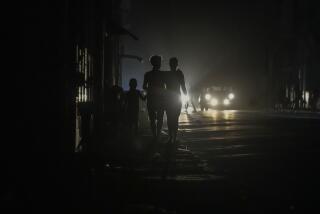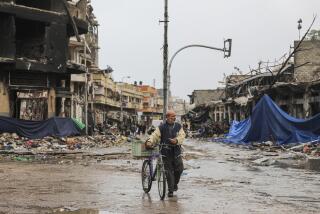160 U.S. Troops Hurt by Rioting Refugees : Panama: More than 1,000 frustrated Cubans break out of camps; most return soon after.
WASHINGTON — About 160 U.S. soldiers suffered mostly minor injuries in two days of riots by rock-throwing Cuban refugees who are increasingly frustrated by their detention in Panama camps, Pentagon officials said here Thursday.
The soldiers, most of whom suffered cuts and bruises, were hurt Wednesday night and Thursday when more than 1,000 refugees broke out of three chain-link-enclosed campsites and commandeered military vehicles in an attempt to flee the area near the Panama Canal.
By Thursday evening, authorities said, most of the refugees had returned to the camps.
Only 17 of the injured soldiers required hospital care, the most serious being treatment for a fractured breastbone. Among the Cubans, three were injured slightly.
U.S. military officials said that, ironically, the disturbances began just hours before it was announced that some of the refugees would be granted asylum in Spain and that others would be given temporary asylum in the United States.
“This is a very serious demonstration,” Brig. Gen. James Wilson, commander of the U.S. refugee operation in Panama, told reporters there early Thursday. “The seriousness of this clearly indicates the frustration these people have with the uncertainty over their future.”
Wilson said he ordered increased security at the camps, and U.S. officials are checking the refugees to see how quickly some of them can qualify for asylum elsewhere.
The protests mark the most serious disturbances at the Panama camps since the United States transferred nearly 9,000 Cuban refugees there in the summer. Most of them had been picked up at sea from flimsy boats or makeshift rafts.
Noting the new transfers to Spain and the United States, the general added: “We hope they will provide the other refugees with a sense of hope.”
Army Maj. Rick Scott, a Pentagon spokesman, said the disturbances began about 4 p.m. Wednesday when 100 Cubans shook their chain-link fence, threw rocks and bottles and broke through the main gate before U.S. military police were able to stop them 50 feet outside the camp perimeter and move them back inside.
“Reports indicate that about 40 U.S. military personnel and one Cuban received minor injuries,” Scott said. “The most serious of which were a broken finger and a broken cheekbone.”
Later Wednesday night, he said, 200 Cubans at another camp broke down a gate, commandeered a military Humvee and used it to knock down some of the chain-link fencing.
“The initial assessment last night was that they were demonstrating to show frustration with the uncertainty of their future,” Scott said. “There did not seem to be any intent to leave and stay gone. They simply wanted their concerns voiced.”
Then, about 9:30 a.m. Thursday, a third disturbance erupted that left 120 U.S. military personnel injured, again with cuts and bruises, when about 1,000 refugees broke out of a third camp and attempted to flee.
But officials in Panama said the refugees soon began returning peacefully to the camp when they realized there was nowhere to run.
“Some of them hung out and a large number of them moved down the road, but eventually they decided to turn around and come back,” Air Force 1st Lt. John Thomas said in a telephone interview from Panama. “Everything is getting back to normal now.”
Added another military official in Panama, who asked not to be identified: “What they were thinking and where they were going to go, who knows? There’s no place nearby they can go.”
He added that the U.S. military built the camps with just chain-link fencing, and no barbed wire or razor wire, because the refugees are not prisoners.
More to Read
Sign up for Essential California
The most important California stories and recommendations in your inbox every morning.
You may occasionally receive promotional content from the Los Angeles Times.











